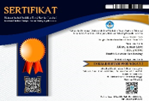ADSORPSI ASETON PADA ARANG AKTIF BIJI ASAM JAWA
DOI:
https://doi.org/10.35799/jis.11.2.2011.203Abstract
ADSORPSI ASETON PADA ARANG AKTIF BIJI ASAM JAWA
Audy D. Wuntu1) dan Vanda S. Kamu1); e-mail: untudenny@yahoo.com
1)Program Studi Kimia FMIPA Universitas Sam Ratulangi Manado, 95115
ABSTRAK
Telah diteliti adsorpsi aseton pada arang aktif yang dibuat dari biji asam jawa (Tamarindus indica) yang diaktivasi dengan NaCl. Penelitian ini bertujuan untuk menentukan parameter adsorpsi, yaitu kapasitas dan energi adsorpsi. Parameter tersebut dihitung dari persamaan regresi linear yang diperoleh dari data adsorpsi aseton pada arang aktif dalam sistem tertutup yang dianalisis menggunakan model isotherm adsorpsi Dubinin-Raduskevich. Sebagai pembanding, prosedur yang sama diterapkan pada arang aktif komersil yang terbuat dari tempurung kelapa. Hasil yang diperoleh menunjukkan bahwa kapasitas adsorpsi aseton pada arang aktif yang dibuat dari biji asam jawa (6,85x10-2 cm3/g) lebih rendah dari kapasitas adsorpsi aseton pada arang aktif komersil (8,98x10-2 cm-3/g). Kecenderungan yang sama teramati juga pada nil;ai energy adsorpsi, yaitu 7,69 kJ/mol pada arang aktif biji asam jawa dan 8,08 kJ/mol pada arang aktif komersil. Untuk meningkatkan kualitas arang aktif biji asam jawa, perlu dilakukan perbaikan dalam proses pembuatan arang aktif preparasi.
Kata kunci: adsorpsi, asam jawa, karbon aktif
Â
ACETONE ADSORPTION ON TAMARIND SEED ACTIVATED CARBON
ABSTRACT
The adsorption of acetone on activated carbon prepared from tamarind (Tamarindus indica) seed activated with NaCl was investigated. The investigation was aimed to calculate the adsorption parameters which were adsorption capacity and energy of acetone on the adsorbent. The parameters were calculated using linear regression equation derived from data of acetone adsorption on the activated carbon in a closed system which was analyzed using Dubinin-Raduskevich adsorption isotherm model. As a comparison, the same procedure was performed on commercial coconut shell activated carbon. The results showed that the adsorption capacity of acetone on tamarind seed activated carbon (6.85x10-2 cm3/g) was lower than that on commercial one (8.98x10-2 cm3/g). The similar trend was observed in the adsorption energy values which were 7.69 kJ/mol on tamarind seed activated carbon and 8.08 kJ/mol on commercial activated carbon. It was suggested that the preparation of tamarind seed to produce activated carbon should be improved.
Keywords : adsorption, tamarind, activated carbon





